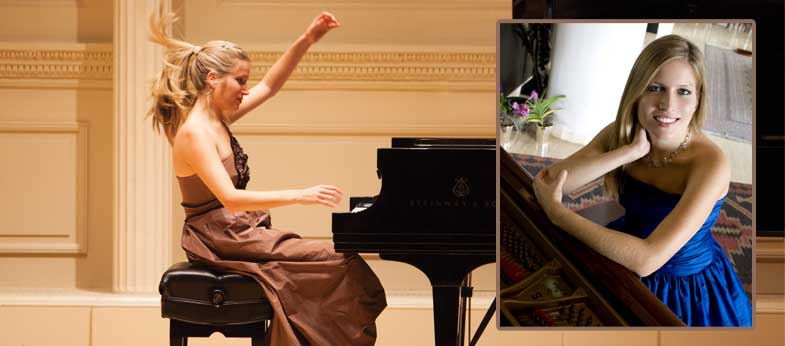
About
Versatile, daring and insightful, Venezuelan pianist Gabriela Martinez is establishing an international reputation for lyrical playing, compelling interpretations and elegant stage presence. She has performed with the world’s leading symphonies including San Francisco Symphony and the Chicago Symphony Orchestra and at such esteemed venues as Carnegie Hall, Avery Fisher Hall, Alice Tully Hall, Salzburg’s Grosses Festspielhaus, Copenhagen’s Tivoli Gardens, and Paris’s Palace of Versailles. She has won critical acclaim for her brilliant technique and aesthetic sensitivity.
Ms. Martinez was the First Prize winner of the Anton G. Rubinstein International Piano Competition, and was a semifinalist at the 12th Van Cliburn International Piano Competition, where she also received the Jury Discretionary Award. She began her piano studies in Caracas with her mother, Alicia Gaggioni, and attended The Juilliard School, where she earned her Bachelor and Master of Music degrees as a full scholarship student of Yoheved Kaplinsky. Ms. Martinez was a fellow of Carnegie Hall’s The Academy, and a member of Ensemble Connect (formerly known as Ensemble ACJW), while concurrently working on her doctoral studies with Marco Antonio de Almeida in Halle, Germany.
Program
Program Notes
Goyescas, subtitled “Los majos enamorados” (The Gallants in Love), is a piano suite of six Romantic character pieces that Granados completed in 1911; he added a seventh piece in 1914. Many people link this work with the paintings of Francisco Goya, comparing the balance between ornamentation and subtlety with the old and new styles the painter brought to the art world. The fourth piece, “Quejas ó la maja y el ruiseñor” (Laments or the Maiden and the Nightingale)—perhaps the most famous of the suite—is a delicate nocturne with figurations and trills designed to emulate the gentle fluttering of a bird and to challenge the pianist’s technique.
Beethoven composed the Bagatelles, Op. 33 in 1801–1802. This was his first published set of bagatelles, but he continued to compose them throughout his career. The seven pieces are typical examples of his early style. They contain many classical elements, including a well-delineated melodic line and an accompaniment that preserves the clarity of the texture. The first bagatelle’s main theme is jaunty and playful, while the brief middle section is a bit weightier. The last bagatelle exhibits characteristic Beethovenian mischief and restlessness, shifting from one idea to the next imaginatively, and then moving back.
Visconti writes that this composition, written in 2014, is inspired by “the primal sound of early medieval music and the beauty with which a simple, chant-like melody becomes beautiful and complex when resonating in a large space. . . . The way in which acoustic resonance can amplify a musician’s true soul seemed like a fitting metaphor as I composed a new work for pianist Gabriela Martinez, a musician who pours all of her spirit into every performance.”
In the same vein as Modest Mussorgsky’s Pictures at an Exhibition, Adam Schoenberg’s Picture Etudes (2013) is a set of piano pieces modeled after various paintings. It differs in being an interpretation of paintings through 21st-century eyes and by including pictures by more than one artist. The source material comes from Bloch, Miró, Van Gogh, and Kandinsky and ranges from perplexing to bubbly, colorful, and intense.
A comparsa is a group of singers, musicians, and dancers who take part in carnivals and other festivities in Spain and Latin America. This piece by Ernesto Lecuona, one of Cuba’s greatest composers, tells a brief story: a carnival procession is approaching from the distance. A syncopated drum rhythm sets the scene with a buoyant Afro-Cuban beat; the two-bar rhythmic pattern is repeated throughout with an infectious effect. A joyous melody is heard as the procession passes directly in front of the listener; and the music fades away as the group recedes, leaving only a last echo of the original drum beat. This work has been adapted and transcribed many times for various instruments and arrangements.
Alberto Ginastera, a leading 20th-century Latin American composer, drew upon musical elements and styles of his native Argentina throughout his career. When he wrote Danzas Argentinas in 1937, during his Objective Nationalism period, he used folk themes fairly directly. The sharply rhythmic first piece is unusual in that the left hand plays only black notes while the right plays only white, resulting in competition between two tonal modes. The second piece, a gentle dance, softens the mood, with a piquant first melody, an expansive middle section, and an enriched close. A wild, furious, and dissonant third dance, capturing the jubilance and bluster of the title’s arrogant cowboy, rounds out the set.